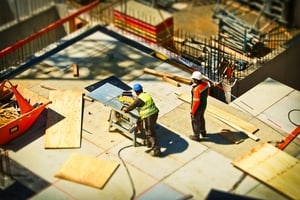How To Get Your Wall, Ceiling, Paint, and Flooring Products Specified For LEED v4
- < Healthy Buildings Can Increase Rental Premiums And Productivity
- > 12 Building Product Specification Strategies For Successful Companies
How can you get your wall, ceiling, paint, and flooring products specified on LEED v4 projects? What strategies will help you increase your specification opportunities for sustainable design projects? Let’s dive in . . .
Getting your CSI Division 9 products specified for LEED projects isn’t difficult. First of all, you need to manufacture a great wall, ceiling, paint, or flooring product. For example, if your flooring product is a cheap imitation of a competitor’s product with design deficiencies and filled with hazardous substances, then you might want to rethink your plan. However, if you manufacture a great CSI Division 9 product, there are simple steps you can take to improve your chances of product specification.
CSI Division 9 consists of many building products including plaster and gypsum board, acoustical ceilings, various flooring products such as wood, bamboo, cork, tile, and paints and coatings. All of these products can benefit from a coherent and focused specification program for LEED v4.
The Three Elements of Division 9 Product Specification
There are three main elements for Division 9 product specification. These elements are the foundation for nearly every building product to get specified with a few variations. The three elements are education, documentation, and architectural specification visits. If your company is missing one of these three elements, you are at a significant disadvantage. If your team integrates all three strategies into your specification and outreach programs, you will expand your LEED v4 project opportunities.
LEED Documentation For Specifiers
Many AEC firms request or mandate that wall, ceiling, paint, and flooring products have transparency documentation. The top three types of sustainability documentation include Health Product Declarations (HPDs), Environmental Product Declarations (EPDs), and Declare Labels. Manufacturers who possess all or some of these documents are more likely to be specified for LEED projects.
LEED v4 launched in 2013, yet it took many years for product manufacturers years to finally develop transparency documentation. Division 9 product manufacturers would be well advised to develop at least HPDs to increase their specification opportunities. AEC firms such as Perkins + Will, HKS, and ZGF require documentation such as HPDs for specification. Surprisingly, many AEC firms are requesting HPDs for products outside the building envelope which is quite unusual. HPDs have been typically requested for products within the building envelope.
Another important document for getting Division 9 products specified on LEED projects, is a LEED data sheet, green sheet, credit sheet, etc. There is no uniform name for this document, but it basically lists your products LEED credit contributions. LEED documentation should be on a manufacturer’s website, easy to download, and current with LEED v4 and LEED v4.1 standards.
Architectural Specification Visits
A critical strategy for getting wall, ceiling, paint, and flooring products specified on LEED projects is architectural specification visits. These visits are different than an AIA lunch and learn at an AEC firm. Making the wrong type of visit at the wrong phase of design is a problem that uninformed building product representatives face. In addition to getting the timing of your visit right, you will need to learn to identify the decision makers in an AEC office, which varies primarily due to the size of the firm.
It can take time to gain a design professional’s trust. Architectural office visits are not a short-term effort; it can take years to work your way into a specifier’s or architect’s good graces, but once you do, you will be an important resource for years to come. The average building construction project requires thousands of product decisions. Some of these are easy, while others are much more difficult, requiring extensive research and coordination. The design professional is constantly inundated with new products from multiple manufacturers, each of them trying to set themselves apart from the competition. How and when you approach the design professional about your products can make the difference.
“Getting the specification” is nothing more than getting the design professional to either write a project specification around your Division 9 product or add it to a list of approved manufacturers/products contained in a project specification. Product substitutions are a fact of life, so be ready to defend the use of your product. Many design professionals, owners, contractors, and other decision makers will be convinced to spend a bit more up front if their downside risk is reduced or eliminated.
Education For LEED Professionals
Many CSI Division 9 product manufacturers already host online AIA courses or deliver AIA webinars. However, several product manufacturers do not have a course registered with the GBCI for LEED professionals to obtain their mandatory education courses for their credential. There are over 100,000 LEED professionals that are required to have mandatory CE hours. This is a huge market for manufacturers.
How can wall, ceiling, paint, and flooring products manufacturers increase brand awareness? Brand awareness is the extent to which your product is recognized by architects, specifiers, contractors, and other design professionals. Brand awareness is one of the first steps for product manufacturers as it affects the specification opportunities that are made when it comes to the phase of product selection.
Online courses registered for both AIA and GBCI CE hours offer a significant marketing advantage over traditional AIA-only courses. Wall, ceiling, paint, and flooring product manufacturers can discuss their product’s LEED contributions, sustainability attributes, and how they can solve architect’s problems. Education equals specification. Out of sight is out of mind, and if your product is not in front of LEED professionals you have less of a chance getting specified on LEED projects.
What are your strategies for product specification for LEED projects? How does your team increase your specification opportunities for green-building projects?
For more information or to discuss the topic of this blog, please contact Brad Blank





